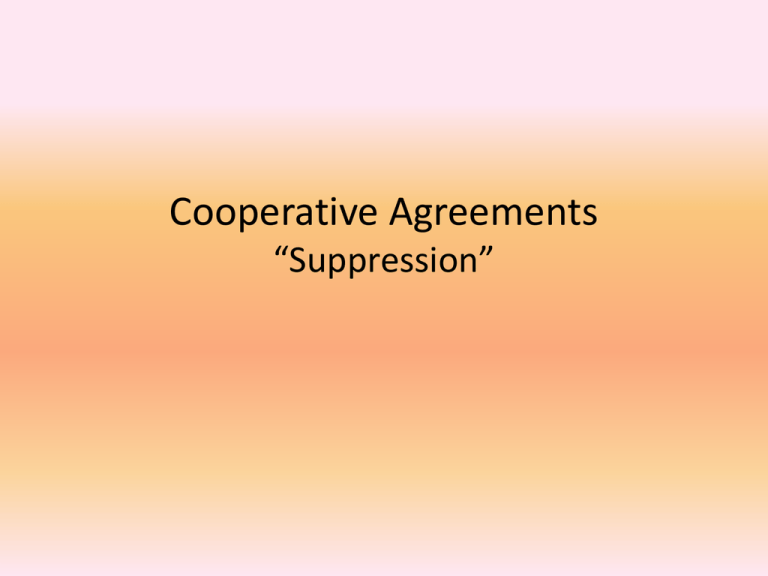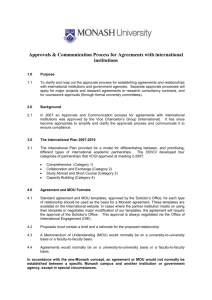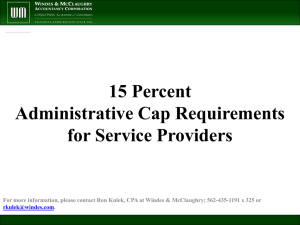Cooperative Agreements
advertisement

Cooperative Agreements “Suppression” What’s that Document? Objectives • Recognize the differences between an agreement and procurement and when to apply each. • Identify common types of agreements and authorities used by Wildland Fire Agencies. • Identify national level agreements that allow for interagency participation in Fire Management activities. Objectives - continued • Define the use of Cooperative Agreements and their operating plans. Interagency Cooperation • Interagency coordination and cooperation are essential at the federal, state, tribal, and local levels. WHY? Interagency Coordination • • • • Intermingled ownerships Efficient use of resources Landscape level planning and treatments Common training, communication, and inter-operability • Reduced budgets Interagency Cooperative Groups • National: NWCG • Geographic Area: PNWCG • Local: Sub-geographic Area groups Cooperative Fire Agreement Flow Chart Cooperative Instruments • • • • Grants Memorandums of Understanding (MOU) Procurements Agreements MOU?? Procurement?? Agreement?? Grant?? Agreement MOU Grant Procurement MOU • Informal Agreement that documents the who, what, how, and why of an interagency relationship • Outlines procedures • Does not allow for payments or “exchange” of anything of value Procurement • Acquire goods or services for the direct benefit of the federal agency. Agreement Many kinds of agreements and authorities. • Mutual interest and benefit • Agency substantially involved in implementation • Transfer something of value to others for public benefit Cooperative Agreements • National Master Agreement signed by the 5 Federal Wildland Fire Agencies • Master Cooperative Wildland Fire Management and Stafford Act Response Agreement ( PNWCG) • Local Cooperative Fire Protection Agreements Authorities • Federal Agency must have legal authority prior to entering any contract, grant, or agreement, which could result in the use, obligation or other commitment of any agency resources. Fire Related Authority • Reciprocal Fire Protection Act of May 22, 1955 (42 USC 1856a; PL 84-46) Authorizes any federal agency with fire protection responsibilities to enter into reciprocal agreements with any fire organization maintaining fire protection facilities adjacent to federal lands or facilities. Master Agreements • List authorities • Defines how agencies will cooperate in broad terms • Authorizes joint activities such as training, dispatching, etc. Operating Plans • Multiple levels –PNW Geographic Area –Local Area • Provides specific details on how the agencies will cooperate. • Reviewed annually and updated if necessary. Supplemental Fire Suppression Agreement (Cost-Share) Master Agreement Exhibit F • Required for multi-jurisdictional fires between federal and state agencies. • Defines the process for sharing costs • R6 and BLM Templates available http://www.fs.fed.us/r6/fire/incidentbusiness/agreements.shtml Local Cooperative Fire Protection Agreements • Local fire protection entities, i.e. Fire Districts • R6 and BLM Templates available http://www.fs.fed.us/r6/fire/incidentbusiness/agreements.shtml • State Entities have Mutual Aid Agreements in place. Tools • Information Being Gathered from FMOs and Center Managers Unit Vale District Type Operating Plan Agreement # OR-RFPA09-1001 List of Fire Agreements Expiration Parties to the agreement Date Remarks Vale BLM; NE Oregon ODF 4/30/2014 Authorizing document is the Master Agreement What Instruments? • Situation 1 • To obtain goods and other services from nonsignatory parties to the R6 Master Agreement during an incident for the exclusive use and benefit of the Federal Government • use a procurement action What Instruments? • Situation 2 • To establish incident cost-sharing responsibilities with a non-Federal entity that IS signatory to the R6 Master Agreement for a multi-jurisdictional fire • Supplemental Fire Suppression What Instruments? • Situation 3 • To obtain from or provide assistance to another Federal agency that IS signatory to the R6 Master Agreement (BLM, NPS, BIA, USFWS) in a fire emergency • no additional agreement is required because "Federal agencies will not bill each other for fire suppression support What Instruments? • Situation 4 • To establish a mutual aid relationship with, OR to obtain from and/or provide services to a nonFederal party that IS NOT signatory to the R6 Master Agreement (e.g., County, City, or Rural Fire District/Department, etc.) for: Personnel, Equipment OR a combination of the above, • http://www.fs.fed.us/r6/fire/incidentbusiness/cooperative-relations-andagreements.shtml What Instruments? • Situation 5 • To plan for and obtain emergency assistance from another NON-wildland management Federal agency (Federal agency NOT signatory to the R6 Master Agreement) • Interagency Agreement format of the "Requesting Agency" (agency providing funds) What Instruments? • Situation 6 • To develop, or to revise (annual update), an Operating Plan with another entity that IS signatory to the R6 Master Agreement (Federal or non- Federal) for suppression-related activity and NOT transferring any funds • Operating Plan Outline Guide in the R6 Master Agreement The Northwest Wildland Fire Protection Agreement (NW Compact Act) INDIAN SPRINGS 2001 History • CIVIL WAR - STATES PROHIBITED FROM ENTERING INTO COMPACTS WITHOUT PERMISSION OF CONGRESS. Authority • NOVEMBER 1998 CONGRESS GAVE PERMISSION BY PASSING PUBLIC LAW 105-377. Membership • • • • • • • • • • Oregon Washington Alaska Idaho Montana Yukon Territory Northwest Territories Province of Saskatchewan Province of British Columbia Province of Alberta Billing Procedure • This entire subject is a hot topic. • Under The Northwest Wildland Fire Protection Agreement (NW Compact Act) Neither the FS or the BLM are signatories to this agreement. • Bills should be between the parties within the agreement. Remember! • Since consistent application of interagency policies and guidelines is essential, procedures in the IIBMH will be followed. • We all have responsibility to ensure that any agreement initiated is in the best interest of the agency. • For Federal include the local Grants and Agreements Coordinator in the development process for all agreements. QUESTIONS? Objectives • Recognize the differences between an agreement and procurement and when to apply each. • Identify common types of agreements and authorities used by Wildland Fire Agencies. • Identify national level agreements that allow for interagency participation in Fire Management activities. Objectives - continued • Define the use of Cooperative Agreements and their operating plans.











